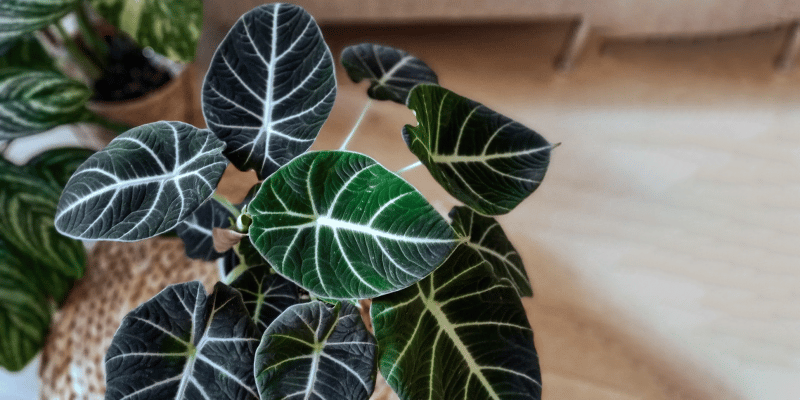Let’s get one thing straight: the Alocasia Black Velvet might be smaller than other Alocasia plants, but it isn’t any less gorgeous! Featuring dark green leaves and eye-popping silvery veins, its smaller spread makes it perfect for less roomy spaces.
Intrigued?
We’ll give you our essential Alocasia Black Velvet care tips and dive into all of the varieties available. Propagation? Easy!
Common issues? We’ve got you covered.
Table of Contents
Alocasia Black Velvet Care Guide
History, habitat, and characteristics
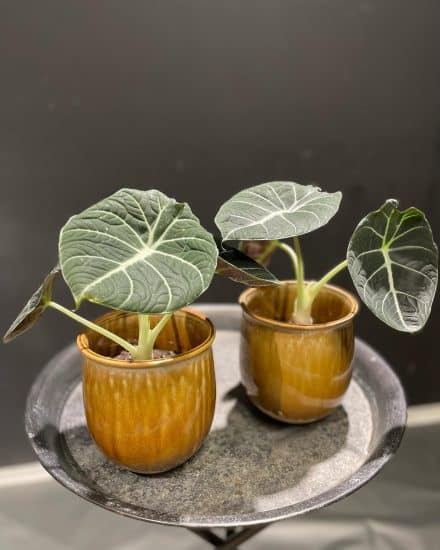
Despite what its name may suggest, Alocasia reginula Black Velvet is its own species, not a cultivar of Alocasia reginula. The term reginula comes from the Latin regina with translates to “little queen.” I have no problem bowing down before this paragon of plant royalty.
Since Alocasia Black Velvet was sold commercially even before it was officially scientifically described in 1998, its origin was a bit of a mystery for a long time. The guy who named it, Scott Hyndman, got it from a Hawaiian arboretum, which in turn got it from a Japanese collector in Borneo.
In 2021, researchers found them growing on limestone cliffs in the Tabin Wildlife Reserve, a nature preserve on the island of Borneo in Sabah, Malaysia. Mystery solved!
From the Aracaea family, this plant can grow up to 1.6 feet tall, making it slightly smaller than other alocasia species such as the giant taro (Alocasia macrorrhizos) or Green Velvet Alocasia. It’s known as one of the jewel alocasias due to its small size, combined with its pronounced texture and eye-catching color.
The Alocasia Black Velvet’s dark green, almost black-looking velvety leaves can reach up to 8 inches long and 5 inches in wide. They have reddish emerald backsides and are sliced through with bold silver veins in the front, creating the serious contrast the species is known for.
But how? These unique leaves are able to shine in any light thanks to the chlorophyll they contain. Alocasia reginula’s bright silver leaf veins reflect almost every color in the light spectrum, while the surrounding “black” leaf itself absorbs this light energy and reflects none of it back to us, creating that striking visual difference.
They’re unlikely to flower inside, but when they do, Alocasia Black Velvet produce a simple white spadex in a pale yellow spathe, which explains why this species is primarily grown for its foliage.
Varieties
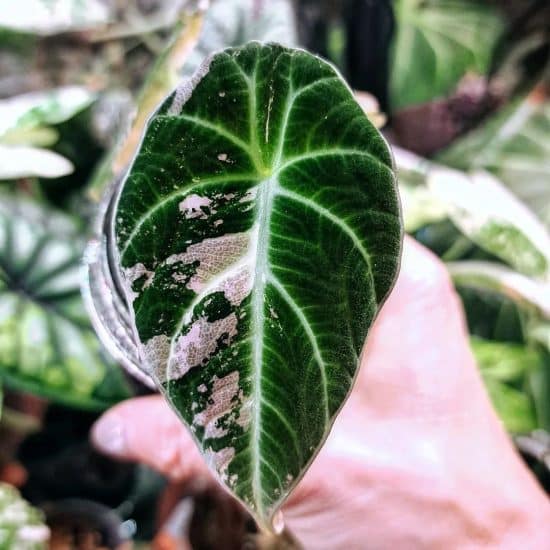
Alocasia Black Velvet has two cultivars and six hybrids so far, with more to come. Here’s how to tell them apart.
Alocasia Black Velvet Cultivars
- Alocasia ‘Black Ninja’ or ‘Black Velvet Night’: Looks a lot like ‘Black Velvet,’ but has double marginal veins (ones that run along the edge of the leaf) and thicker leaves.
- Alocasia ‘Silver Velvet’: Also resembles ‘Black Velvet,’ but the adaxial (upper) side of the leaf has a silvery grey tint.
- Alocasia Black Velvet Pink Variegated: A gorgeous, rare variation with pink splotches contrasting with the dark green, almost black appearance of the rest of the leaf. It’s made by tissue culturing in a lab, which is prone to mutations like this one. They’re usually unstable, and new leaves may revert, but you can trim any entirely green ones off if you want to try and encourage more variation.
Alocasia Black Velvet Hybrids
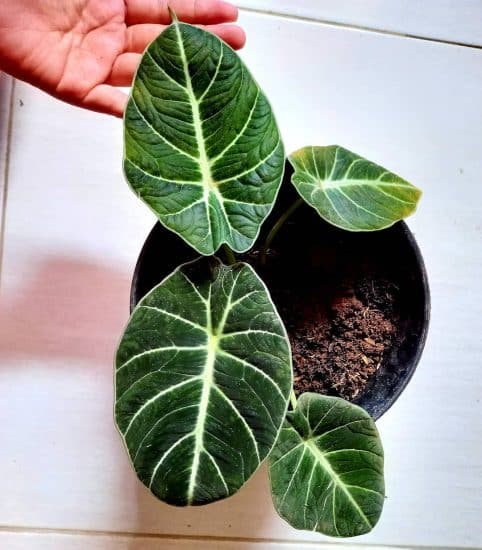
- Alocasia ‘Black Dragon’ or ‘Black Dragon Scale’: Formed by crossing Alocasia Black Velvet with Alocasia ‘Silver Dragon,’ it has glossy, deeply textured dark green leaves that can be difficult to tell apart from other hybrids.
- Alocasia ‘Maharani’ or ‘Grey Dragon’: A cross between Alocasia Black Velvet and Alocasia melo, this is a lovely jewel alocasia with small green leaves that have pronounced, deep veins resembling scales.
- Alocasia ‘Regal Shield’: A cross of Alocasia Black Velvet and Alocasia odora with thick dark green leaves that are purple with green veins on the top half that transition to yellow-green veins on the bottom half.
As if that weren’t enough, there are some even more recent hybrids — think 2022 — like Alocasia ‘Kalila’, Alocasia ‘Ulla’, and Alocasia ‘Katya’ that aren’t very well-known yet. This could change in the future, though. All three were created by crossing Alocasia ‘Bisma’ with Alocasia Black Velvet. A triple whammy!
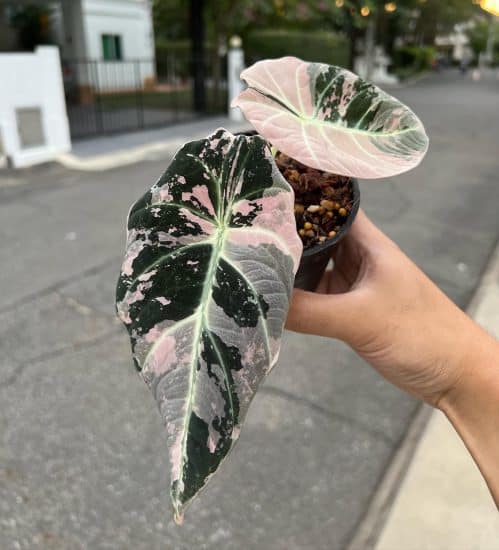
Now that you’ve got this plant’s history, physical characteristics, and varieties down pat, let’s get into its ideal environmental needs.
Light
Alocasia Black Velvet requires bright, indirect light to thrive. This means putting it in areas with light conditions similar to those found beneath the jungle canopy. To create this lighting environment indoors, find a spot close to a window that gets bright light, but doesn’t leave your plant directly exposed to the sun.
Keep an eye out for signs of too little light, such as yellowing, pale foliage, and slow or limited growth. If the plant is receiving too much light, it may exhibit discoloration, wilting leaves, and leaf scorching along the edges.
If you’re worried about the amount of direct light your Alocasia is getting, you can either move it a few feet back from the window, block the sun’s rays with a sheer curtain, or place a piece of furniture or taller plant in front of the window.
Water
Watering an Alocasia Black Velvet houseplant can be a process of trial and error at first, but that’s okay! The goal is to ensure that the soil is evenly moistened without becoming too wet, as otherwise this plant is prone to root rot.
One of the best indicators for knowing when to water is to use your finger to check the soil about 1 to 2 inches down. When it’s dry, it’s time to pour! But be careful not to overwater.
If your Alocasia Black Velvet is being overwatered, you may observe yellow or brown spots on the leaves, leaf drop, and stunted growth. On the other hand, if your plant isn’t receiving enough water, you may notice dark brown or black tips on the leaves that indicate dehydration.
In the winter months, when your plant is dormant, water much less frequently to avoid overwatering. If there is a question as to how much and how often to water, a good rule of thumb is to allow the soil to dry out completely between waterings.
Temperature and humidity
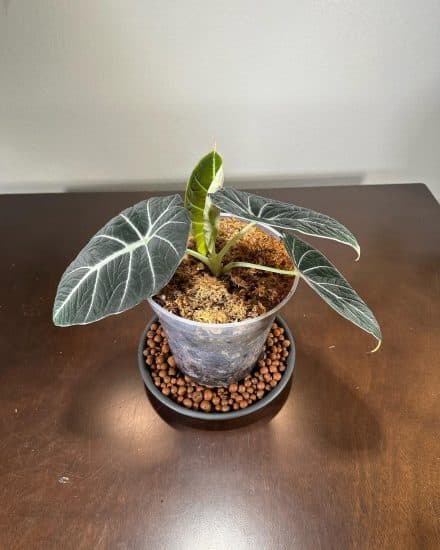
Alocasia Black Velvet is native to humid climates, so in order to keep it healthy, you have to create a similar environment in your home. This plant prefers to stay cozily between temperatures of 65°-80°F.
Though it’s a hardy houseplant, if temperatures dip below 60°, things can get dicey. Try to keep it away from drafty areas and avoid exposing it to drastic temperature changes, like what you might find near vents or windowsills. If temperatures are too low, this could lead to stunted growth, wilting leaves, and curling leaf tips.
Alocasia Black Velvet loves higher levels of humidity, similar to what its native tropical environment provides. Humidity levels between 60% and 70% are essential for this plant. Lower levels could cause dry textures on the leaf tips and crispy edges on leaves, as well as susceptibility to disease and pests.
To get your humidity levels up:
- Consider investing in a humidifier.
- Create a simple pebble tray: fill a tray with small stones and add a bit of distilled water. This will help the water evaporate and increase the humidity for your plant without affecting the rest of your home.
- Place it temporarily in a bathroom, since it will benefit from the steam produced by hot showers.
If you need help monitoring the humidity level, you can always buy an inexpensive hygrometer. This will help your houseplant get the exact warmth and moisture it needs to grow.
Soil and planting
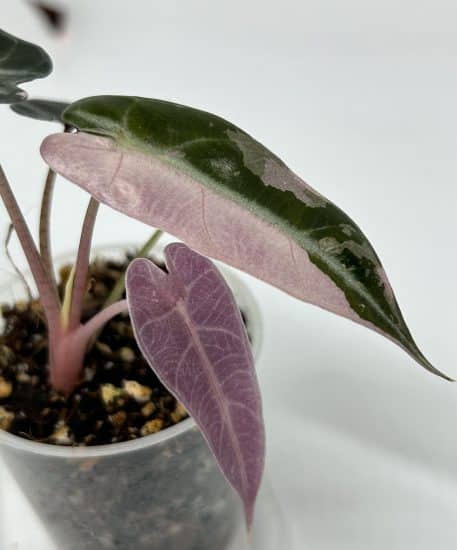
An ideal soil mix for the Black Velvet Alocasia provides proper aeration and hydration for the plant’s extensive root system, as well as important nutrients for the plant. It should be slightly acidic, with a 5.5-6.5 pH.
Aim to create a potting soil mix similar to:
- 50% organic potting mix or topsoil
- 20% perlite or pumice
- 20% sphagnum peat moss
- 10% coco coir
Optional extras for more aeration include:
- LECA
- Orchid Bark
- Vermicast (worm castings)
As long as the mix lets water flow through easily while retaining moisture at the same time, it should work just fine.
Fertilizing
To maintain proper moisture levels and pH balance in the soil, fertilize your Alocasia Black Velvet with a balanced liquid houseplant fertilizer once a month during the spring and summer months.
Take a break from fertilizing in the fall and winter season to avoid any fertilizer burn. Winter fertilization can harm your plant’s roots, since it will be dormant during this time and unable to uptake the nutrients anyway.
Pruning
Alocasia Black Velvet doesn’t require much pruning other than the usual snipping away dead or dying leaves so new ones can grow. Your plant will lose leaves naturally as new ones form, which helps direct energy and nutrients to support healthy future foliage.
Repotting
Since this plant grows quickly and prefers being slightly root bound, it won’t need to be repotted often—usually every two to three years. When it does, however, use your fingers or a chopstick to gently encourage its roots out of the pot. Let as much of the soil fall away from the roots as you can.
Place your plant in a new, rectangular pot (which is wider than it is high) and fill it with suitable soil mix.
Avoid using round pots if possible, since the horizontal roots won’t fit as well and will require more frequent repotting. Finally, ensure the pot has adequate drainage hole to avoid standing water and root rot.
Light, water, temperature and humidity, soil requirements? Check. Now let’s discover how to make more Black Velvet plants for yourself and friends!
Propagation guide
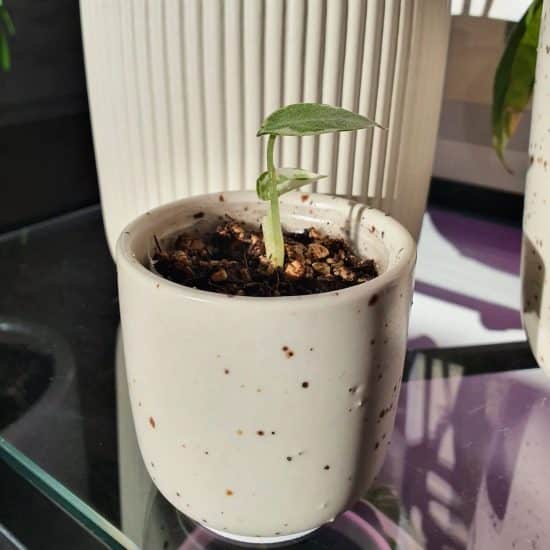
Since Alocasia Black Velvet doesn’t technically have stems, but instead grows blades from a central corm, you can’t propagate it by stem cuttings. Luckily, that’s not your only option. With this plant, you can either divide its rootball or harvest corms.
Whichever route you choose, make sure you use a healthy mature specimen, and try to propagate while repotting, since this is far less stressful for the plant.
Propagate your Alocasia Black Velvet plant by division if: you want a free and easy method that fuels quick growth. Note that each root division has to be developed enough to support a new plant, so this may not be the ideal process for super young plants (but you shouldn’t technically be trying to propagate those until they’re more well-developed anyway).
Propagate by corm harvesting if: you have an older plant with many corms already available, or your plant’s roots are tangled and difficult to split up. Keep in mind that this option takes some time and patience as mature plants develop.
Division propagation:
- Carefully dust off any excess root soil. Make sure each potential division has a few roots of its own roots.
- Use a sterilized knife or shears to make vertical cuts to divide the roots.
- Plant the roots in their own pot with an appropriate soil mix (see “Soil and planting” section above). Make sure the soil remains moist but not sopping.
- Place your separated plant in bright, indirect light and give it increasingly more light as it develops.
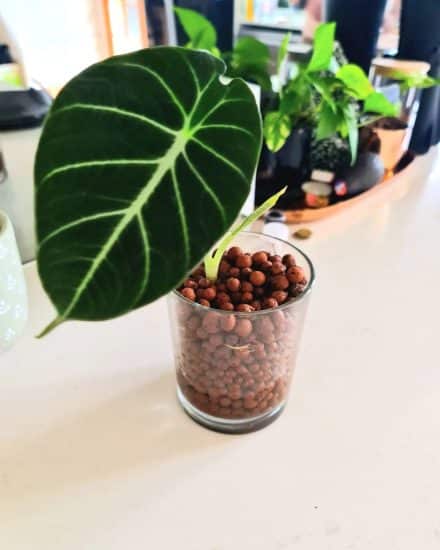
Corm harvest propagation:
- Your Alocasia Black Velvet will have more corms if it’s been a while since you repotted it or if it’s an older plant in general. Search for these amid the roots with your fingers, looking for small round bulbs. Some will be easy to spot and separate, while others might need to be snipped off of the mother plant right where they join.
- Peel the corm’s tunic, or hard outer layer (who knew corms wore clothes too!) off with your fingers. If you find it difficult, you can dunk the corms in water to soften them for a few minutes first. I highly recommend Aloha Plant Life’s informative video about the entire corm harvesting process. They suggest placing the corms in bottlecaps, which is a brilliant idea. Just make sure the corm is facing upright with the pointy tip up and the rougher side facing downward.
- Cover the bottlecaps or other vessels of choice with an upside-down jar. This will help maintain high humidity. Place both in a well-lighted area.
- At some point within the next month and a half, the corms will curl out in fleshy white layers that resemble small rose petals. The first leaf will push out from its center.
- Shortly after that, you’ll see tiny white roots growing below and the development of the first leaf. If you used a bottle cap, move the corm to a slightly larger water jar as its roots grow to avoid entanglement issues later.
- Now that your corm has developed larger roots and a full first leaf, plant it in a coarse, well-draining potting mix. Make sure it gets high humidity and has constantly moist soil. And that’s it! Propagation accomplished.
Fun fact: Alocasia Black Velvet is propagated commercially by growers using tissue culture. This is a complex method that requires more steps than we lowly plant owners can complete at home, but it is effective for fast mass production.
You know how to propagate — now let’s tackle how to deal with common problems. Yellowing leaves? Spider mite infestation? No sweat!
Common issues
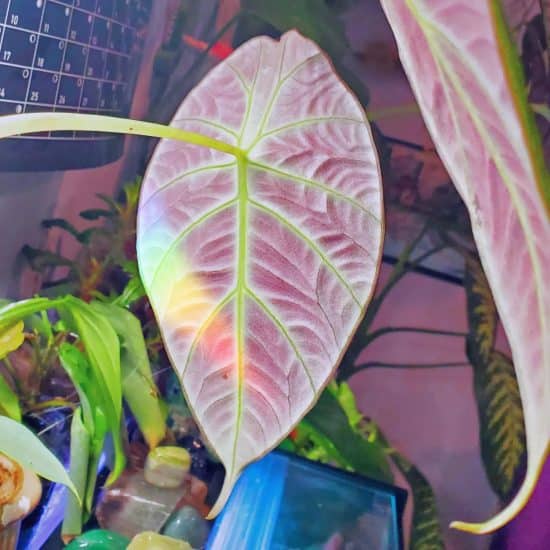
When you’re the proud owner of a new Alocasia Black Velvet plant, care can seem a bit tricky at first. In most instances, though, with a few simple water, light, and nutrient changes, your plant will be back to looking velvety and gorgeous in no time!
Brown leaves: If there are brown leaf tips or spots, it might be an indication of too little water or excessive fertilizer. The leaves may also suffer discoloration if they are exposed to direct sunlight or extreme temperature changes, so watch to make sure your Alocasia is getting plenty of sun (but not too much!).
If your plant has been exposed to direct sunlight, move it to an area with indirect or filtered light as soon as possible.
Yellow leaves: Too much or too little water can cause stress to your plant’s root system, resulting in yellowing of the leaves. To avoid this issue, water your plant only when the top few inches of soil is dry. Make sure your plant also has proper drainage holes to prevent the roots from sitting in soggy soil.
Calcium deficiency: Sometimes Alocasia Black Velvet can suffer from calcium deficiency, which is characterized by leaves that start to yellow between the veins and may even wrinkle up or curl. It can also appear faded or dull and exhibit stunted growth. This can be caused by too little lighting, too much water, or too much nitrogen in the soil.
Make sure your plant is getting bright but indirect sunlight, and that you’re allowing at least the top two inches of soil to dry out completely before watering again. Lastly, check the NPK ratio of your soil – it should have more Phosphorus (P) than Nitrogen (N), and Calcium (K) should be the highest of all three.
Drooping leaves: If you detect leaf drooping, it could be a sign that your plant is thirsty! Droopy leaves are basically nature’s way of saying your Alocasia Black Velvet needs a drink. Don’t be afraid to give your plant extra love, and be sure to water consistently. Lastly, if the leaves are curling or curving, the culprit may be too little water or not quite enough humidity.
Diseases and pests
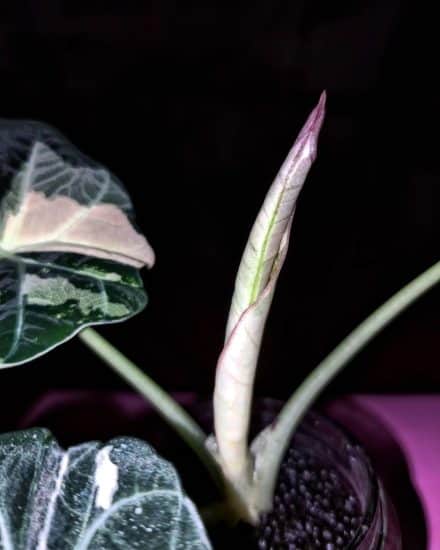
It’s important to be aware of the various diseases and pests that may plague your Alocasia Black Velvet. Don’t worry, just like us, plants sometimes get a case of the sniffles. With little bit of care and attention, you can help your Alocasia Black Velvet quickly get back to good health!
Fungal infection. The Alocasia Black Velvet plant is prone to fungal diseases which can be easily identified by yellowing foliage, dark spotting, and blackening leaves. In addition, a white fuzzy growth on the leaves or around the soil may be present.
To fix this, start by cutting off and discarding any affected leaves. Then treat with a fungicide and adjust your watering schedule to ensure the fungus does not return.
Root rot. Almost always caused by overly moist soil. This can cause yellowing and wilting of the leaves along with brown tips and spots. To check for rotting roots, examine the soil. If it is waterlogged, then this is your issue.
Let your soil dry out completely before you water again. The next step is to check the roots. Pull the plant out and look for any slimy or mushy roots; if present, cut these off before re-potting in fresh potting soil.
Pests. The most common problem you may encounter is tiny, yet tenacious, spider mites. You’ll spot these guys by their signature webbing and yellowing or discolored leaves. Your plant can also suffer from other common insects like aphids and thrips (small black bugs), and mealybugs. Mealybugs are small white insects that congregate in small masses on leaves and stems and give off a white waxy coating.
Have no fear — you can easily eliminate these pesky invaders with a simple spritz of an insecticide spray or a diluted solution of rubbing alcohol. Make sure to isolate your plant from others at the first sign of an infestation until the problem is thoroughly contained, since you don’t want those spider mites hopping to your next plant!
Also, quick note on rubbing alcohol. Studies show that diluting it actually makes it work a lot better for disinfecting and pest removal. Some amount of water is necessary for helping it permeate cell walls, so avoid the 99% unless you’re cleaning electronics!
Conclusion
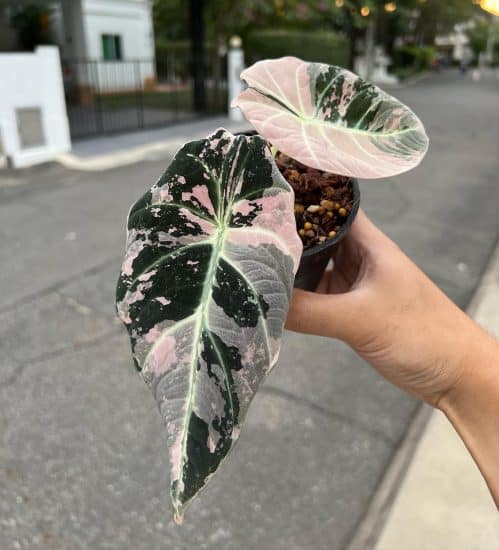
Potentially the most charming dwarf of the Alocasia species, Alocasia Black Velvet is a high-contrast feast for the eyes. Crisscrossed by shiny silver veins, its dark green leaves almost look black.
Give this plant the normal household temps, high humidity, and aerated, well-draining soil it needs, and you’ll have a healthy plant to propagate by division or corm harvest in no time!
If you found this article informative, feel free to share it with a friend. Ask us anything on Facebook or Twitter — we’re always happy to answer any burning plant-related questions.
FAQ
Are Alocasia Black Velvet hard to care for?
While it’s not a “set it and forget it” type of plant like the Sansevieria, Alocasia Black Velvet isn’t difficult to care for. Pay attention to its household temp, high humidity, coarse and free-draining soil needs, and you’ll find the Black Velvet is a beautiful, durable houseplant that can thrive under the right conditions.
Is Alocasia Black Velvet rare?
Not anymore! While they used to be fairly rare, in the past few years, Alocasia ‘Black Velvet’ has been popping up more and more in garden stores and nurseries at much more affordable prices.
Can you touch Alocasia Black Velvet?
Like all Alocasia plants, the Black Velvet is toxic because of the calcium oxalate crystals in its stems and blades, so keep it out of reach of humans and pets.
Do Alocasia Black Velvet like to be misted?
While you can mist around the leaves of your plant on occasion, take care not to mist them directly, since this could contribute to leaf spot or spider mites. Keep in mind that misting shouldn’t be your plant’s only source of humidity, just a temporary source of moisture increase in the air. (See the “Temperature and humidity” section above for more).
Sources
- https://powo.science.kew.org/taxon/1006568-1
- https://www.rhs.org.uk/plants/136801/alocasia-black-velvet/details
- https://pdfs.semanticscholar.org/6414/46a5de6a6d748ecef74bc1ccd62073aa94da.pdf
- https://www.biodiversitylibrary.org/page/43660563#page/286/mode/1up
- https://www.aroidpedia.com/journal/alocasia-reginula

